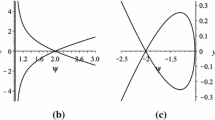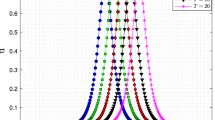Abstract
Comparisons are made between three different methods for computing the stable solitary wave solution for the FitzHugh-Nagumo equations which consist of a nonlinear diffusion equation coupled to an ordinary differential equation in time. They model the Hodgkin-Huxley equations which describe the propagation of the nerve impulse down the axon. Two of the methods involve the travelling wave equations. Previous accurate numerical computations of these equations as an initial-value problem using a shooting method lead to inaccurate values for the wave speed; however, nonlinear corrections to the initial values are shown to yield accurate values. A boundary-value method applies “asymptotic boundary conditions” and uses a spline-collocation code called COLSYS for numerical solution of boundary-value problems which leads to accurate wave profiles and speeds. The third method is to solve an initial-boundary-value problem with an adaptive outgoing wave condition for the partial differential equations where the solitary wave emerges as the stable long time solution. The concept of a “wave integral” is introduced and they are derived to determine the wave speed used in the adaptive boundary condition and to measure the closeness of the computed solutions to the exact solitary wave solution.
Similar content being viewed by others
References
Ascher, U., Christiansen, J., Russell, R. D.: A collocation solver for mixed order systems of boundary value problems. Math. Comp. 33, 659–679 (1979)
Ascher, U., Christiansen, J., Russell, R. D.: Collocation software for boundary value ODE's. ACM Trans. Math. Software. 7, 209–222 (1981)
Carpenter, G. A.: Travelling wave solutions of nerve impulse equations. Ph.D. thesis. Madison: University of Wisconsin 1974
Casten, R. G., Cohen, H., Lagerstrom, P. A.: Perturbation analysis of an approximation to the Hodgkin-Huxley theory. Quart. Appl. Math. 32, 365–402 (1975)
Conley, C. C.: Private communication. See Hastings On the existence of homoclinic and periodic orbits for the FitzHugh-Nagumo equations. Quart. J. Math. (2) 27, 123–134 (1976)
Copeland, B.: A guide to programs which solve variations of the FitzHugh-Nagumo equations and the equations for spreading depression. The Institute of Applied Mathematics and Statistics Tech. Rept. No. 79-13. Vancouver: The University of British Columbia 1979
De Boor, C.: CADRE: An algorithm for numerical quadrature. In: Mathematical software (Rice, J.R., ed.), pp. 417–449. New York: Academic Press 1971
Evans, J. W., Feroe, J.: Local stability theory of the nerve impulse. Math. Biosci. 37, 23–50 (1977)
FitzHugh, R.: Impulses and physiological states in theoretical models of nerve membrane. Biophys. J. 1, 445–466 (1961)
FitzHugh, R.: Motion picture of nerve impulse propagation using computer animation. J. Appl. Physiol. 25, 628–630 (1968)
FitzHugh, R.: Mathematical models of excitation and propagation in nerve. In: Biological engineering (Schwan, H. P., ed.), pp. 1–85. New York: McGraw-Hill 1969
FitzHugh, R., Antosiewicz, H. A.: Automatic computation of nerve excitation — detailed corrections and additions. J. Soc. Indust. Appl. Math. 7, 447–458 (1959)
Fornberg, B., Whitham, G. B.: A numerical and theoretical study of certain nonlinear wave phenomena. Phil. Trans. R. Soc. London A289, 373–404 (1978)
Hassard, B. D.: Computation of invariant manifolds. In: New approches to nonlinear problems in dynamics (Holmes, P. J., ed.), pp. 27–42. Philadelphia: SIAM 1980
Hastings, S. P.: On the existence of homoclinic and periodic orbits for the FitzHugh-Nagumo equations. Quart. J. Math. (2) 27, 123–134 (1976)
Hastings, S. P.: Single and multiple pulse waves for the FitzHugh-Nagumo equations. SIAM J. Appl. Math. (in press)
Hodgkin, A. L., Huxley, A. F.: A quantitative description of membrane current and its application to conduction and excitation in nerve. J. Physiol. 117, 500–544 (1952)
Lees, M.: An extrapolated Crank-Nicolson difference scheme for quasilinear parabolic equations. In: Nonlinear partial differential equations (Ames, W. F., ed.), pp. 193–201. New York: Academic Press 1967
Lentini, M., Keller, H. B.: Boundary value problems on semi-infinite intervals and their numerical solution. Preprint (in press)
Miura, R. M: The Korteweg-de Vries equation: A survey of results. SIAM Rev. 18, 412–459 (1976)
Miura, R. M.: Explicit roots of the cubic polynomial and applications. Appl. Math. Notes 5, 22–40 (1980)
Nagumo, J., Arimoto, S., Yoshizawa, S.: An active pulse transmission line simulating nerve axon. Proc. IREE 50, 2061–2070 (1962)
Rinzel, J.: Integration and propagation of neuroelectric signals. In: Studies in mathematical biology, part I: Cellular behaviour and the development of pattern (Levin, S. A., ed.). Studies in mathematics, vol. 15, pp. 1–66. The Mathematical Association of America 1978
Rinzel, J.: Repetitive nerve impulse propagation: Numerical results and methods. In: Nonlinear diffusion (Fitzgibbon, W. E., Walker, H. F., eds.), pp. 186–212. London: Pitman 1977
Shampine, L. F., Gordon, M. K.: Computer solution of ordinary differential equations: The initial value problem. San Franciso: W. H. Freeman and Co. 1975
Tuckwell, H. C., Miura, R. M.: A mathematical model for spreading cortical depression. Biophys. J. 23, 257–276 (1978)
Author information
Authors and Affiliations
Additional information
This work was supported in part by the Natural Sciences and Engineering Research Council Canada under Grant A4559 and by the John Simon Guggenheim Memorial Foundation
Rights and permissions
About this article
Cite this article
Miura, R.M. Accurate computation of the stable solitary wave for the FitzHugh-Nagumo equations. J. Math. Biology 13, 247–269 (1982). https://doi.org/10.1007/BF00276063
Received:
Revised:
Issue Date:
DOI: https://doi.org/10.1007/BF00276063




